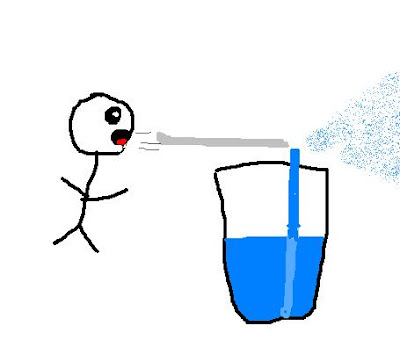This is how you create a 'reach in' fish tank.
 Start off with this tank. It is really simple, just a tank with a hole at the side. But with just a hole, air will bubblie in, so let's make the wall penetrate downwards a bit more so that the air will have a harder time bubbling in.
Start off with this tank. It is really simple, just a tank with a hole at the side. But with just a hole, air will bubblie in, so let's make the wall penetrate downwards a bit more so that the air will have a harder time bubbling in.WARNING: Provided the height of water is low enough such that the pressure at the depth of the whole is less than atmospheric pressure. the water will (hopefully) not flow out. However, if the column of water is too high, atmospheric pressure will not be able to support the weight.
Atmospheric pressure is 760 mmHg. Since mercury is 13.5 times denser than water, 1 atmosphere will hold up 10260 mm = 10 metres of water. As long as you conform to that height limit, the tank is safe.
 Next you add your fish and plants and stuff inside the tank. Now visitors to your interactive tank will be able to feed your fish and touch your fish.
Next you add your fish and plants and stuff inside the tank. Now visitors to your interactive tank will be able to feed your fish and touch your fish.Warning: Ventilating your tank with an oxygen pump is NOT a good idea. The oxygen will soon displace the water and your fish will be soon swimming in air. Instead, be sure to get someone to design an extremely complicated system for channeling the water out of your tank and aerating it in a chamber independent of the tank, then pumping it back in.
Warning: Do not place exotic fishes in your tank. People might steal them.
And you're done! Probably the worst thing that can happen now would be this.
 So just make sure that you keep a lookout every now and then.
So just make sure that you keep a lookout every now and then.SECTION 2 - THE BALOONEY EQUATION (sorry I found the common mispronunciation so funny that I just had to put it down)
In a closed system, energy has to be conserved. This basically means that the gravitational potential energy, kinetic energy and pressure exerted perpendicular to the direction of liquid flow is more or less the same.
In other words: Pressure + Density*gravitational acceleration*height+0/5*density *velocity^2 is a constant throughout the system.
Whatever that means, just now that the faster something flows the less pressure it exerts and the lower its height the faster it flows. Makes sense doesn't it? Things go faster as it go downhill.
Just as usual, the lecture was boring.
The demonstrations were just a tad more interesting.

Erm... I guess many of us had seen this many times. Air flows around the ball, causing a region of low pressure around it. When it goes out of balance, the surrounding stationary air with higher pressure pushes it back in.

Atomizer. Water gets sucked up and a cocktail of body fluids and water is sprayed out.

Some burrow design by prairie dogs. Different shape of entrances to allow different flow speeds at different entraces, resulting in a pressure difference that allows ventilation.
I hope the next lesson will be more interesting.
No comments:
Post a Comment